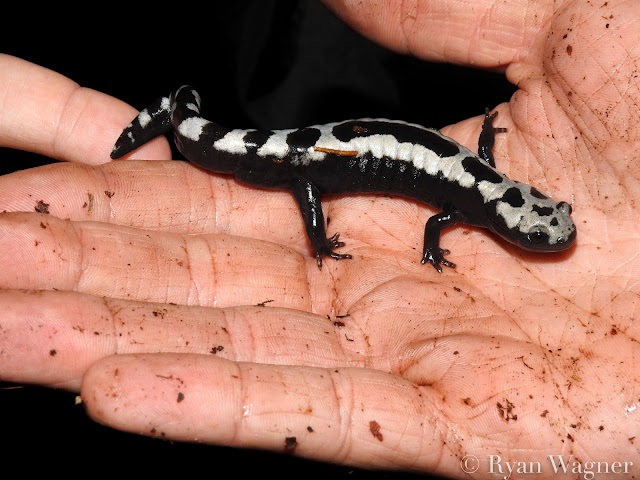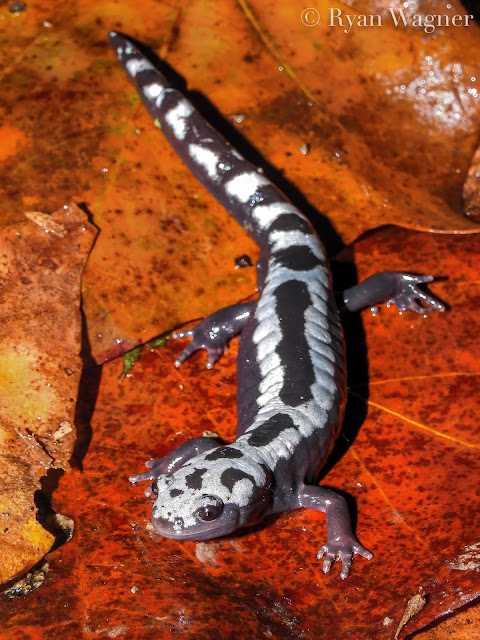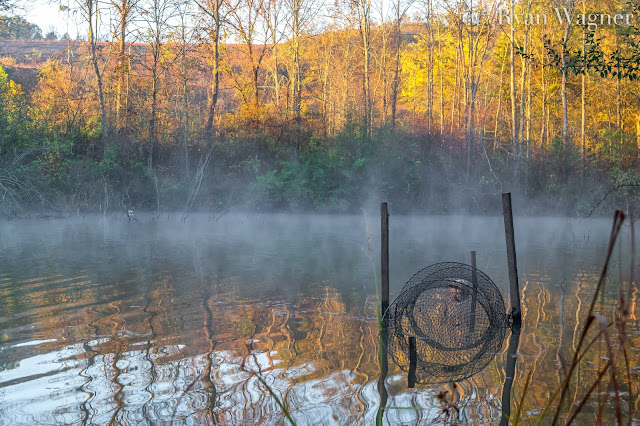It was raining. My water-logged boots had turned my feet into prunes long ago. Storms from one of the recent hurricanes had brought a steady downpour that continued throughout the mild October afternoon. Carl Brune and I were out on one of the final snake trips of the season. With autumn temperatures steadily dropping with each passing day, the reptiles were few and far between. After spending a miserable rain-soaked day hunting for snakes, we decided to do what any sane person would: spend a rain-soaked night hunting for salamanders.
We started our amphibian search road cruising after dark. The weather seemed perfect, and with the scarcity of reptiles, we were eager for some action. The trouble with road cruising in autumn is that the pavement is often covered in fallen leaves and other debris. Spotting the shiny, hot-dog bodies of salamanders is difficult even when roads are clear. Green frogs, on the other hand, were out in force, franticly slip-sliding on splayed legs across the frictionless road. Like tiny body surfers, they hydroplaned over the two-lanes on shear momentum.
After about an hour of nothing but frogs, we stepped out into the storm to hike the road on foot. It was an eery night, silent except for the distant sound of rock-n-roll. An amish horse and buggy trotted out of the darkness, quickly switching off the blaring music as it passed us (a bit peculiar I thought). As the beam of my flashlight fell on the night's first marbled salamander (Ambystoma opacum), I was transported back to a similar night nearly a year before.
It was another rainy day in early October 2016, only a few months into my freshman year at Ohio University. It felt like a lifetime since I had left campus. Going so long without seeing any wildlife had me in a rut. When I received an email that a professor was looking to round up some undergrads for a salamander hike, I jumped at the opportunity. As the sun set, a small group of eager salamander seekers gathered behind Irvine hall.
Dr. Carl Brune, an OU physics professor, introduced himself to the group. His camera and headlamp only hinted at his encyclopedic knowledge regarding Ohio’s reptiles and amphibians. Accompanying us was a small film crew, intending to document some of OU’s undergrad field research. With Marcel Weigand, a first-year graduate student (studying box turtles of course), behind the wheel, we set off. I didn't know it at the time, but both Marcel and Carl would become major influences in my herping and undergraduate careers (check out the research I did with Marcel HERE).
 |
| My first Marbled. |
As the van bounced along, the others talked of spring salamander ranges and recalled experiences with eastern spadefoots. I couldn't help but grin in anticipation. I had dreamed of seeing Ohio’s different herpetofauna for years, but until now, lacked the means and the know-how. With this knew-found camaraderie, herping had never felt more possible. Crammed on all sides by rain-gear clad researchers, I knew I was exactly where I was meant to be.
It was a short drive to the location—a well loved spot among OU herpers. We parked along the side of the road and filed out of the car. Half a dozen flashlights sprung to life. I had seen my share of salamander migrations growing up in northeastern Ohio—but never one in the fall.
The marbled salamander is an oddity among mole (ambystomid) salamanders. These rotund, four and a quarter inch sallies breed not in the spring (like their spotted and Jefferson cousins) but in the fall. On stormy October nights, they emerge from mammal burrows where they have spent the summer and head in the direction of vernal pools. Peculiarly, marbled salamander courtship takes place on land. Plump with eggs, females cannot swim and risk drowning if they enter the water. Hidden beneath rocks, logs, and clumps of grass, the females guard their clutch until rising water levels overtake the nest.
The marbled salamander is an oddity among mole (ambystomid) salamanders. These rotund, four and a quarter inch sallies breed not in the spring (like their spotted and Jefferson cousins) but in the fall. On stormy October nights, they emerge from mammal burrows where they have spent the summer and head in the direction of vernal pools. Peculiarly, marbled salamander courtship takes place on land. Plump with eggs, females cannot swim and risk drowning if they enter the water. Hidden beneath rocks, logs, and clumps of grass, the females guard their clutch until rising water levels overtake the nest.
Laying eyes on my first marbled was a dream come true. Our team split up, searching the road and the adjacent bike path. Coyotes took up howling as the light rain pattered all around us.
When someone announced the first salamander of the night, I raced down the path unable to contain my excitement. A plump, black, curled C plopped into my cupped hands. The salamander sat motionless, eyes blinking in the bright light of my headlamp. True to its name, the salamander’s back and head were elegantly patterned with white bars and splotches. Its expression seemed perplexed, as if it was wondering, “how did I suddenly get four feet off the ground.”
The final video. My camera and Cleveland Metroparks
hat make an appearance in the first few seconds.
I lay on my belly, eye-to-eye with another naturally single-minded creature. When photographing or observing wildlife, I can't help but get tunnel vision (much to the annoyance of my friends). I don't know what it is about herps that so enchants me. Watching the way they move with such intense purpose, it's easy to get pulled into their world. They have one set goal in mind, and nothing (not even being picked up by giants with flashing lights) is going to dishearten them. These unassuming creatures have more to teach us than we give them credit.
I returned home feeling revitalized and eager to get back out in the field. I never would have imagined the adventures to come. Exactly 12 months later, Carl and I were back out on a rainy road. We found a few small marbleds and one spotted. It was a slow night, but a nostalgic one. Sometimes I don't know where the time goes. What will I be nostalgic for in another year's time? . . .















